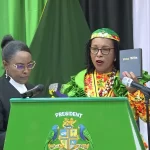Kalinago Language

Kalinago Language is vital to Dominica’s indigenous heritage, particularly within the Kalinago Territory. Once widespread among the Kalinago people, this language has significantly declined due to European colonisation and the subsequent adoption of French Kwéyol and English. However, efforts to revive and preserve the Kalinago language are ongoing, as it remains a key element of the island’s cultural identity.
Revival and Preservation Efforts of the Kalinago Language
In recent years, there has been a strong push to revive the Kalinago Language through educational initiatives and community efforts. Cultural leaders in the Kalinago Territory emphasise the importance of language in preserving the community’s heritage and passing it on to future generations. Programs aimed at teaching the language to younger generations have been introduced, and there is a growing movement to integrate the language into school curriculums.
Cultural Significance and Legacy
The Kalinago Language is deeply intertwined with Dominica’s place names, traditions, and cultural expressions. Many of the island’s villages, such as Itassi (Vieille Case), Layou, and Calibishie, retain their original Kalinago names, a testament to the language’s enduring legacy. Additionally, everyday words in Dominica, like “Agouti” and “Sisserou,” have Kalinago origins, reflecting the language’s influence on the island’s everyday life.
Reviving the Kalinago Language is not just about preserving words; it is about honoring a civilization that has contributed significantly to Dominica’s cultural landscape.




